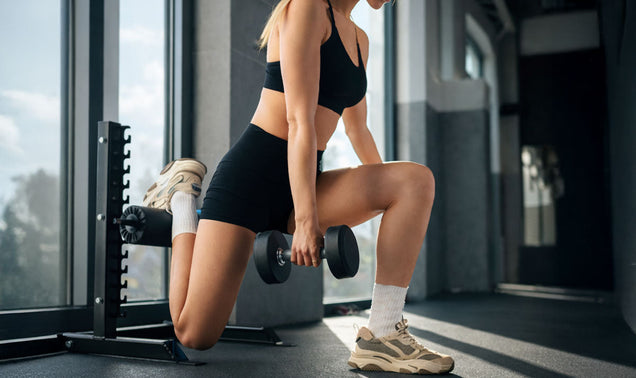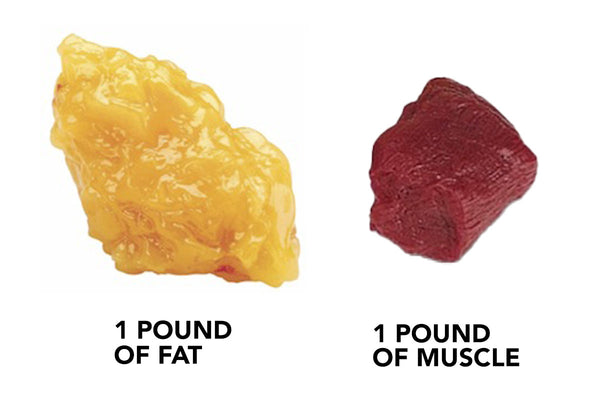Losing fat and building muscle (aka body recomposition) is a goal many of us have, especially those of us new to fitness culture. While body recomp is sold as “trading fat for muscle,” the human body doesn’t actually convert fat cells into muscle cells. Two separate, but very important, processes are occurring -- fat loss and muscle growth.
Let’s Dive into what exactly happens when you’re seeking fat loss and muscle growth as well as the optimal way to achieve your goals!
The Big Difference Between Muscle & Fat
While there are three different types of muscle cells in the body (skeletal, cardiac, and smooth), when it comes to losing fat and building muscle, we’re referring to increasing the amount of skeletal muscle. So, for the purposes of this article, when we say “muscle cells” we’re referring to skeletal muscle.
With that said…
Muscle Cells
Muscle is made of bundles of muscle fibers known as myofibrils. Each myofibril contains smaller fibers made of long chains of amino acids, including essential amino acids (EAAs) and non-essential amino acids.[1,2]
Amino acids have a central atom of carbon bonded to an amino group (NH2), a carboxyl group (COOH), and a hydrogen atom. This may seem like unnecessary information, but it’ll make a lot more sense in a few paragraphs.
In addition to serving as the building blocks for our muscles, amino acids also are used to synthesize collagen, which supports skin, hair, nails and joint health, as well as all hormone production, digestion, and immune function.
Fat Cells
Fat cells, also known as adipocytes, serve as a reservoir of calories (energy) that our bodies can access during times of scarcity. They’re made up of triglycerides, which consist of a glycerol backbone and three fatty acid chains.
Similar to muscle cells, there are different types of fat cells throughout the body; however, fat cells are only composed of carbon, hydrogen, and oxygen atoms.[3,4]
Why is this important?
Since muscle cells and fat cells have different chemical structures, our bodies do not convert one into the other. In other words, muscle cannot be converted into fat and vice versa. Makeups, neither can be converted into the other.[5]
Changes During Weight Loss
When we say we want to “lose weight” what we really mean is that we want to lose body fat, since actual weight loss can include a mixture of fat loss, muscle loss, and water weight loss.
In order to lose weight, you must create (and maintain) a calorie deficit whereby you ingest fewer calories than you expend on a daily basis. This is most successfully (and sustainably) accomplished through a mixture of increasing energy output (i.e. physical activity) and decreasing energy intake (i.e. a reduced calorie diet).
Not it’s easy to fall into the trap of “if a little is good, then more is better.” However, creating too large of a calorie deficit can lead to excessive fatigue, irritability, and most unfortunately -- muscle loss.
You see, muscle is very “expensive” for the body to maintain from an energy standpoint. In the midst of a calorie deficit the body will conserve energy by lowering your metabolic rate and breaking down those tissues it doesn’t need (like those bigger than average biceps).
To prevent muscle breakdown when dieting for fat loss, there are two things you must do:
- Consume enough daily protein (for dieting, we suggest consuming between 1-1.2 grams of protein per pound of bodyweight)
- Perform resistance training 3-4x per week
As we mentioned before, protein supplies the body with the raw materials (amino acids) it needs to repair, sustain, and build muscle. Resistance training provides an incredibly powerful stimulus that tells your body “I NEED THESE MUSCLES!” This helps ensure that when your body starts looking for energy sources, it turns to fat tissue and not muscle tissue.
So, how does the body burn fat for energy?
Well, during low level activities (walking, sitting, house chores, etc.) the body mostly burns fat for energy. Think of it as the “slow burning fuel” and carbohydrates (glucose, glycogen, etc.) as the “fast burning fuel” your muscles need during physically demanding activities (like HIIT, resistance training, circuit training, etc.).
Triglycerides stored in fat cells are broken down (via a process called lipolysis) into glycerol and free fatty acids. These fatty acids are then transported into the mitochondria, with the help of L-Carnitine, where they are used to produce adenosine triphosphate (ATP) -- the body’s “celllular currency” of energy production.
This process of “burning fat for fuel” is technically known as beta oxidation and produces water and carbon dioxide as byproducts which are then excreted in urine and sweat and exhaled during breathing, respectively. These are both exhaled during breathing and excreted via urine and sweat.
Essentially, when you’re burning fat, you’re actually using it for energy production, not building new muscle tissue.
How to Lose Fat
Putting everything together, here is a simple and straightforward solution to lose fat.
- Maintain a moderate deficit of ~500 calories per day (this averages out to eating 10–20% less calories than you normally do)
- Perform resistance training workouts 3-4 times per week (this can include free weights, body weight exercises, machines, cables, suspension trainers or resistance bands)
- Add cardio, as needed to create your calorie deficit (cardio increases energy expenditure and may allow you to eat slightly more calories each day while remaining in a deficit which can improve overall energy levels and performance during resistance training sessions)
If you need help figuring out how many calories to eat for fat loss and/or an effective resistance training program to build muscle while losing fat, then download the 1UP Fitness App where we’ll help you figure all of that out, for FREE!
What About Supplements?
Supplements can offer tremendous help with achieving your fitness and physique goals. However, they are most beneficial when you have a solid foundation (i.e. nutrition, training, and sleep).
Once your foundation is set, then you can look to add in a few supplements where you think you could use some extra help. Among the first supplements individuals consider purchasing, regardless of fat loss or muscle gain, are staples like a multi-vitamin and whey protein powder.
For some individuals that struggle with hunger or energy levels during a fat loss phase, we’d suggest looking into our Stim-Free Appetite Suppressant as well as our best-selling body recomposition aids, Make Her Lean Max, Pro Ripped Max, and Stim-Free Fat Burner.
For those that aren’t bothered by feeling a little hungry but want an extra push for those early morning cardio sessions and resistance training workouts, we’d suggest our performance-enhancing pre workouts, 1UP Pre Men and 1UP Pre Women.
The Bottom Line on Fat Loss and Muscle Growth
Losing fat and building muscle are two separate processes.
While they can occur at the same time, it usually is better to dedicate separate phases to each one (spend 8-12 weeks dieting and 12-16 weeks building muscle). This allows you to really dial-in your nutrition and tracking and focus all of your efforts on a singular goal as opposed to trying to juggle two goals at once.
If you’re looking for added motivation to jumpstart your health and fitness journey, join our 8-week transformation challenge where we’re giving away $50,000 in Cash and Prizes to 10 Total WINNERS. (5 Female and 5 Male)!
References
- Dave HD, Shook M, Varacallo M. Anatomy, Skeletal Muscle. [Updated 2023 Aug 28]. In: StatPearls [Internet]. Treasure Island (FL): StatPearls Publishing; 2024 Jan-. Available from:https://www.ncbi.nlm.nih.gov/books/NBK537236/
- Mukund K, Subramaniam S. Skeletal muscle: A review of molecular structure and function, in health and disease. Wiley Interdiscip Rev Syst Biol Med. 2020 Jan;12(1):e1462. doi: 10.1002/wsbm.1462. Epub 2019 Aug 13. PMID: 31407867; PMCID: PMC6916202.
- Cohen P, Spiegelman BM. Cell biology of fat storage. Mol Biol Cell. 2016 Aug 15;27(16):2523-7. doi: 10.1091/mbc.E15-10-0749. PMID: 27528697; PMCID: PMC4985254.
- Rosen ED, Spiegelman BM. What we talk about when we talk about fat. Cell. 2014 Jan 16;156(1-2):20-44. doi: 10.1016/j.cell.2013.12.012. PMID: 24439368; PMCID: PMC3934003.
- Pedersen BK. Muscle-to-fat interaction: a two-way street? J Physiol. 2010 Jan 1;588(Pt 1):21. doi: 10.1113/jphysiol.2009.184747. PMID: 20045903; PMCID: PMC2821541.






